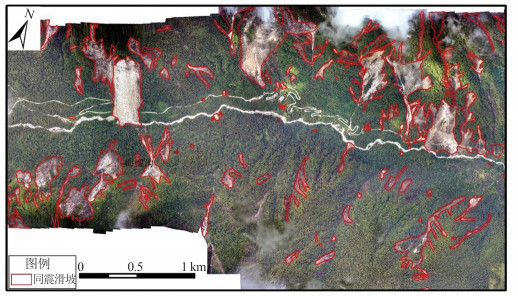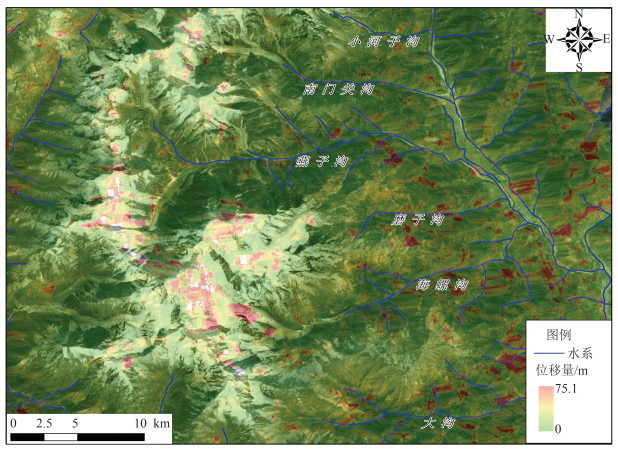Emergency Analysis of the Impact of the Luding Ms 6.8 Earthquake on Hailuogou Glacier
-
摘要: 2022-09-05四川省甘孜州泸定县发生Ms 6.8地震,震中距离海螺沟冰川约10 km,海螺沟冰川受此次地震影响如何,受到社会广泛关切。利用多时相Landsat 8和Sentinel-2光学卫星影像,基于归一化雪覆盖指数对海螺沟冰川面积进行监测,并利用Sentinel-1雷达卫星影像,基于像素偏移追踪技术对海螺沟地震前和震中位移进行监测。结果表明,2016―2022年海螺沟冰川8月份面积呈波动变化趋势,与日平均最高气温具有负相关性,冰川运动速度与地形坡度和日平均最高气温具有正相关性。泸定地震未造成海螺沟冰川运动速度大范围显著增大,但对冰瀑布前缘区域扰动明显。震后冰崩直接致灾可能性较小,但增加了泥石流致灾风险。Abstract:Objectives On 5th September 2022, an Ms 6.8 earthquake struck Luding County, Ganzi Prefecture, Sichuan Province, China, with the epicenter about 10 km away from Hailuogou Glacier. The affect of this earthquake on Hailuogou Glacier has been widely concerned by the society.Methods Firstly, the glacier area is monitored based on normalized difference snow index using multi-temporal Landsat 8 and Sentinel-2 optical satellite images. Secondly, Sentinel-1 synthetic aperture radar satellite image is used to monitor the displacement before and during the Luding earthquake based on pixel offset tracking technology.Results The results indicate that the area of Hailuogou Glacier shows a shaking trend from 2016 to 2022, which have a negative correlation with the daily average maximum temperature. While the velocity has a positively correlation with the slope gradient and the daily average maximum temperature. The Luding earthquake did not cause a significant increase in the velocity of Hailuogou Glaciers in a large range, but it significantly disturbed the front area of the ice waterfall.Conclusions The possibility of direct disaster caused by ice avalanches after the earthquake was low, but which increased the risk of disaster caused by debris flow.
-
致谢: 感谢四川测绘地理信息局、四川省国防科技情报研究所和深圳飞马机器人科技有限公司提供震后遥感数据,同时感谢欧洲空间局提供的Sentinel-1雷达卫星数据和美国Planet卫星公司提供的Planet光学卫星数据。本文撰写过程中参考了中国科学院、水利部成都山地灾害与环境研究所刘巧研究员震后发表的关于地震对海螺沟冰川影响的相关科普论文,在此表示感谢。
-
表 1 本研究中使用的卫星影像数据
Table 1 Satellite Images Used in This Study
年份 卫星 分辨率/m 采集日期 2016 Landsat 8 30 2016-08-25 2017 Landsat 8 30 2017-09-13 2018 Sentinel-2 10 2018-08-28 2019 Landsat 8 30 2019-08-25 2020 Sentinel-2 10 2020-08-27 2021 Sentinel-2 10 2021-08-02 2022 Sentinel-2 10 2022-08-12 -
[1] 王欣, 方成勇, 唐小川, 等. 泸定Ms 6.8级地震诱发滑坡应急评价研究[J]. 武汉大学学报(信息科学版), 2022, DOI: 10.13203/J.whugis20220586. Wang Xin, Fang Chengyong, Tang Xiaochuan, et al. Research on Emergency Evaluation of Landslides Induced by Luding Ms 6.8 Earthquake[J]. Geomatics and Information Science of Wuhan University, 2022, DOI: 10.13203/J.whugis20220586.
[2] 范宣梅, 王欣, 戴岚欣, 等. 2022年Ms 6.8级泸定地震诱发地质灾害特征与空间分布规律研究[J]. 工程地质学报, 2022. http://www.gcdz.org/article/id/77d603ac-db72-4aac-822e-f37abe547b9c. Fan Xuanmei, Wang Xin, Dai Lanxin, et al. Characteristics and Spatial Distribution Pattern of Ms 6.8 Luding Earthquake Occurred on September 5, 2022[J]. Journal of Engineering Geology, 2022. http://www.gcdz.org/article/id/77d603ac-db72-4aac-822e-f37abe547b9c.
[3] 程佳, 徐锡伟. 巴颜喀拉块体周缘强震间应力作用与丛集活动特征初步分析[J]. 地震地质, 2018, 40(1): 133-154. doi: 10.3969/j.issn.0253-4967.2018.01.011 Cheng Jia, Xu Xiwei. Features of Earthquake Clustering from Calculation of Coulomb Stress Around the Bayan Har Block, Tibetan Plateau[J]. Seismology and Geology, 2018, 40(1): 133-154. doi: 10.3969/j.issn.0253-4967.2018.01.011
[4] 白明坤, Chevalier Marie-Luce, 李海兵, 等. 鲜水河断裂带乾宁段晚第四纪走滑速率及区域强震危险性研究[J]. 地质学报, 2022, 96(7): 2312-2332. doi: 10.3969/j.issn.0001-5717.2022.07.005 Bai Mingkun, MarieLuce C, Li Haibing, et al. Late Quaternary Slip Rate and Earthquake Hazard Along the Qianning Segment, Xianshuihe Fault[J]. Acta Geologica Sinica, 2022, 96(7): 2312-2332. doi: 10.3969/j.issn.0001-5717.2022.07.005
[5] 徐锡伟, 吴熙彦, 于贵华, 等. 中国大陆高震级地震危险区判定的地震地质学标志及其应用[J]. 地震地质, 2017, 39(2): 219-275. doi: 10.3969/j.issn.0253-4967.2017.02.001 Xu Xiwei, Wu Xiyan, Yu Guihua, et al. Seismo-Geological Signatures for Identifying M≥7.0 Earthquake Risk Areas and Their Premilimary Application in China's Mainland[J]. Seismology and Geology, 2017, 39(2): 219-275. doi: 10.3969/j.issn.0253-4967.2017.02.001
[6] 邓起东, 程绍平, 马冀, 等. 青藏高原地震活动特征及当前地震活动形势[J]. 地球物理学报, 2014, 57(7): 2025-2042. https://www.cnki.com.cn/Article/CJFDTOTAL-DQWX201407001.htm Deng Qidong, Cheng Shaoping, Ma Ji, et al. Seismic Activities and Earthquake Potential in the Tibetan Plateau[J]. Chinese Journal of Geophysics, 2014, 57(7): 2025-2042. https://www.cnki.com.cn/Article/CJFDTOTAL-DQWX201407001.htm
[7] 王敏杰, 李天斌, 孟陆波, 等. 四川"Y字形"断裂交汇部应力场反演分析[J]. 铁道科学与工程学报, 2015, 12(5): 1088-1095. doi: 10.3969/j.issn.1672-7029.2015.05.016 Wang Minjie, Li Tianbin, Meng Lubo, et al. Back Analysis of Stress Field in the Intersection Region of Y Shaped Fault, Sichuan[J]. Journal of Railway Science and Engineering, 2015, 12(5): 1088-1095. doi: 10.3969/j.issn.1672-7029.2015.05.016
[8] 徐晶, 邵志刚, 马宏生, 等. 鲜水河断裂带库仑应力演化与强震间关系[J]. 地球物理学报, 2013, 56(4): 1146-1158. https://www.cnki.com.cn/Article/CJFDTOTAL-DQWX201304012.htm Xu Jing, Shao Zhigang, Ma Hongsheng, et al. Evolution of Coulomb Stress and Stress Interaction Among Strong Earthquakes Along the Xianshuihe Fault Zone[J]. Chinese Journal of Geophysics, 2013, 56(4): 1146-1158. https://www.cnki.com.cn/Article/CJFDTOTAL-DQWX201304012.htm
[9] 熊维, 谭凯, 余鹏飞, 等. 鲜水河断裂近期库仑应力演化及其与康定Mw 5.9地震的关系[J]. 大地测量与地球动力学, 2016, 36(2): 95-100. https://www.cnki.com.cn/Article/CJFDTOTAL-DKXB201602001.htm Xiong Wei, Tan Kai, Yu Pengfei, et al. Triggering of Mw 5.9 Kangding Earthquake by Coulomb Stress Evolution Along Xianshuihe Fault Zone Since 1955[J]. Journal of Geodesy and Geodynamics, 2016, 36(2): 95-100. https://www.cnki.com.cn/Article/CJFDTOTAL-DKXB201602001.htm
[10] 刘国祥, 张波, 张瑞, 等. 联合卫星SAR和地基SAR的海螺沟冰川动态变化及次生滑坡灾害监测[J]. 武汉大学学报(信息科学版), 2019, 44(7): 980-995. doi: 10.13203/j.whugis20190077 Liu Guoxiang, Zhang Bo, Zhang Rui, et al. Monitoring Dynamics of Hailuogou Glacier and the Secondary Landslide Disasters Based on Combination of Satellite SAR and Ground-Based SAR[J]. Geomatics and Information Science of Wuhan University, 2019, 44(7): 980-995. doi: 10.13203/j.whugis20190077
[11] 刘巧, 刘时银, 张勇, 等. 贡嘎山海螺沟冰川消融区表面消融特征及其近期变化[J]. 冰川冻土, 2011, 33(2): 227-236. https://www.cnki.com.cn/Article/CJFDTOTAL-BCDT201102004.htm Liu Qiao, Liu Shiyin, Zhang Yong, et al. Surface Ablation Features and Recent Variation of the Lower Ablation Area of the Hailuogou Glacier, Mt. Gongga[J]. Journal of Glaciology and Geocryology, 2011, 33(2): 227-236. https://www.cnki.com.cn/Article/CJFDTOTAL-BCDT201102004.htm
[12] 刘巧, 张勇. 贡嘎山海洋型冰川监测与研究: 历史、现状与展望[J]. 山地学报, 2017, 35(5): 717-726. https://www.cnki.com.cn/Article/CJFDTOTAL-SDYA201705013.htm Liu Qiao, Zhang Yong. Studies on the Dynamics of Monsoonal Temperate Glaciers in Mt. Gongga: A Review[J]. Mountain Research, 2017, 35(5): 717-726. https://www.cnki.com.cn/Article/CJFDTOTAL-SDYA201705013.htm
[13] Wang L C, Yu K, Chang L, et al. Response of Glacier Area Variation to Climate Change in the Kaidu-Kongque River Basin, Southern Tianshan Mountains During the last 20 Years[J]. China Geology, 2021, 4(3): 389-401.
[14] 吴仁哲, 黄心茹, 李勇, 等. 布加岗日地区冰川1994至2016年雪线变化及其影响因素分析[J]. 测绘地理信息, 2020, DOI: 10.14188/j.2095-6045.2020075. Wu Renzhe, Huang Xinru, Li Yong, et al. Analysis of the Snow Line Change and its Influencing Factors in the Glaciers in Bugyai Kangri Region from 1994 to 2016[J]. Journal of Geomatics, 2020, DOI: 10.14188/j.2095-6045.2020075.
[15] Pratibha S, Kulkarni A V. Decadal Change in Supraglacial Debris Cover in Baspa Basin, Western Himalaya[J]. Current Science, 2018, 114(4): 792.
[16] 陆会燕, 李为乐, 许强, 等. 光学遥感与InSAR结合的金沙江白格滑坡上下游滑坡隐患早期识别[J]. 武汉大学学报(信息科学版), 2019, 44(9): 1342-1354. doi: 10.13203/j.whugis20190086 Lu Huiyan, Li Weile, Xu Qiang, et al. Early Detection of Landslides in the Upstream and Downstream Areas of the Baige Landslide, the Jinsha River Based on Optical Remote Sensing and InSAR Technologies[J]. Geomatics and Information Science of Wuhan University, 2019, 44(9): 1342-1354. doi: 10.13203/j.whugis20190086
[17] 邓方慧, 周春霞, 王泽民, 等. 利用偏移量跟踪测定Amery冰架冰流汇合区的冰流速[J]. 武汉大学学报(信息科学版), 2015, 40(7): 901-906. doi: 10.13203/j.whugis20130653 Deng Fanghui, Zhou Chunxia, Wang Zemin, et al. Ice-Flow Velocity Derivation of the Confluence Zone of the Amery Ice Shelf Using Offset-Tracking Method[J]. Geomatics and Information Science of Wuhan University, 2015, 40(7): 901-906. doi: 10.13203/j.whugis20130653
[18] Wasowski J, Bovenga F. Investigating Landslides and Unstable Slopes with Satellite Multi Temporal Interferometry: Current Issues and Future Perspectives[J]. Engineering Geology, 2014, 174: 103-138.
-
期刊类型引用(30)
1. 刘焱雄,陈义兰,杨龙,高珊. 基于测绘学角度探讨海岸线及其测定方法. 海洋科学进展. 2024(03): 425-436 .  百度学术
百度学术
2. 王继鹏,金云智,辛忠华,吉才宇,郭龙. 基于PSO-BP的北斗卫星导航海底高程拟合技术的研究. 天然气与石油. 2024(06): 153-160 .  百度学术
百度学术
3. 付五洲,许宝华,陆彬,李涛. 重力场模型在长江口岛礁垂直基准建立中的应用. 现代测绘. 2023(04): 57-60 .  百度学术
百度学术
4. 王双喜,肖强,孙雪洁. 复杂海域高精度海底地形测量关键问题研究. 海洋技术学报. 2022(01): 7-12 .  百度学术
百度学术
5. 周颖,王瑞. 远海PPK测量潮位用于深度基准面计算的研究. 港工技术. 2022(02): 23-26 .  百度学术
百度学术
6. 柯灝,赵建虎,周丰年,吴敬文,暴景阳,赵祥伟,谢朋朋. 联合大地水准面、海面地形和潮波运动数值模拟的长江口陆海垂直基准转换关系. 武汉大学学报(信息科学版). 2022(05): 731-737+746 .  百度学术
百度学术
7. 单瑞,李浩军,刘慧敏,赵钊,董凌宇,杜凯. GNSS PPP/INS紧组合模式下的远海无验潮水深测量. 海洋地质前沿. 2022(10): 87-93 .  百度学术
百度学术
8. 张颖,闫玉茹,章家保,李静,裘露露. 潮滩冲淤观测技术发展现状. 海洋科学. 2021(03): 152-162 .  百度学术
百度学术
9. 王森,刘立龙,黄良珂,周威. 基于潮汐调和分析的全球定位系统-多路径反射测量技术潮位预报. 科学技术与工程. 2021(09): 3481-3486 .  百度学术
百度学术
10. 魏荣灏,陈佳兵,徐达. 基于PPK无验潮的水下地形测量技术研究. 海洋技术学报. 2021(01): 57-62 .  百度学术
百度学术
11. 王挺,王萃. GNSS-PPK在远距离潮位观测的应用研究. 江西测绘. 2021(04): 8-11 .  百度学术
百度学术
12. 王正杰,王峰,吴自银,曹振轶,罗孝文,李守军. 基于GPS PPK技术确定测深点瞬时潮位及分析. 海洋技术学报. 2020(02): 58-63 .  百度学术
百度学术
13. 王小刚,赵薛强,许军. 珠江口瞬时水位解算方法研究及应用. 水利水电技术. 2020(11): 117-124 .  百度学术
百度学术
14. 梁冠辉,陶常飞,周兴华,周东旭,王朝阳. 新型远距离验潮系统集成设计与研制. 海洋科学进展. 2019(01): 129-139 .  百度学术
百度学术
15. 王智明,孙月文. 无验潮模式下的宁波杭州湾水下地形测量. 城市勘测. 2019(02): 157-159 .  百度学术
百度学术
16. 陈正伟,韩磊. 基于高精度GNSS定位解算及姿态数据获取潮位研究. 海洋技术学报. 2019(05): 55-59 .  百度学术
百度学术
17. 李梦昊,王胜利,高兴国,陈冠旭,刘焱雄. 基于混合编程的实时精密单点定位方法. 海岸工程. 2018(01): 66-73 .  百度学术
百度学术
18. 黄辰虎,陆秀平,边刚,黄贤源,管明雷,翟国君,黄谟涛. 中短期验潮站验潮零点不规则漂移精密处理. 武汉大学学报(信息科学版). 2018(11): 1673-1680 .  百度学术
百度学术
19. Yuanxi YANG,Tianhe XU,Shuqiang XUE. Progresses and Prospects of Marine Geodetic Datum and Marine Navigation in China. Journal of Geodesy and Geoinformation Science. 2018(01): 16-24 .  必应学术
必应学术
20. 臧建飞,范士杰,易昌华,秦学彬,华亮,麻德明. 实时精密单点定位的远海实时GPS潮汐观测. 测绘科学. 2017(06): 155-160 .  百度学术
百度学术
21. 臧建飞,范士杰,易昌华,秦学彬,陈冠旭,华亮. 远海实时GPS潮汐的实时精密单点定位观测. 测绘科学. 2017(08): 79-84 .  百度学术
百度学术
22. 杨元喜,徐天河,薛树强. 我国海洋大地测量基准与海洋导航技术研究进展与展望. 测绘学报. 2017(01): 1-8 .  百度学术
百度学术
23. 赵建虎,欧阳永忠,王爱学. 海底地形测量技术现状及发展趋势. 测绘学报. 2017(10): 1786-1794 .  百度学术
百度学术
24. 王朝阳,周兴华,李延刚,梁冠辉,付延光. 远距离GNSS潮位测量精度的影响因素研究. 海洋技术学报. 2017(03): 1-6 .  百度学术
百度学术
25. 辛保稳,李友龙. GPS PPK技术在海底地形测量中的应用. 科技展望. 2017(18): 161 .  百度学术
百度学术
26. 杨涛,葛俊洁,李路. GPS测量技术及其在工程测量中的应用. 电子测试. 2016(06): 126+125 .  百度学术
百度学术
27. 暴景阳,翟国君,许军. 海洋垂直基准及转换的技术途径分析. 武汉大学学报(信息科学版). 2016(01): 52-57 .  百度学术
百度学术
28. 周东旭,周兴华,梁冠辉,王朝阳,杨磊. GPS浮标天线高的动态标定方法. 测绘科学. 2015(12): 121-124 .  百度学术
百度学术
29. 赵建虎,王爱学. 精密海洋测量与数据处理技术及其应用进展. 海洋测绘. 2015(06): 1-7 .  百度学术
百度学术
30. 赵元元,殷行. 土地测量中GPS实时动态技术的应用研究. 价值工程. 2015(20): 161-162 .  百度学术
百度学术
其他类型引用(6)






 下载:
下载:













